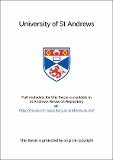Files in this item
Enzyme-catalysed carbohydrate biosynthesis and modification
Item metadata
| dc.contributor.advisor | Naismith, James | en |
| dc.contributor.author | Merkel, Alexandra B. | en |
| dc.coverage.spatial | 239, 22 p : ill. (some col.) 30 cm. | en |
| dc.date.accessioned | 2021-04-08T08:57:07Z | |
| dc.date.available | 2021-04-08T08:57:07Z | |
| dc.date.issued | 2005 | |
| dc.identifier.uri | https://hdl.handle.net/10023/21837 | |
| dc.description.abstract | Glycopeptides are regarded as the last line of defence antibiotics. Since their peptide backbone has no biological activity, these compounds depend on attached carbohydrates for their antibacterial potency, as well as for their selectivity and specificity. In Amycolatopsis orientalis, five enzymes are responsible for the synthesis of the L-epivancosamine deoxysugar from dTDP-glucose in the chloroeremomycin biosynthesis. This thesis discusses the structural characterisation of two of these enzymes: EvaD, a 5-epimerase; and EvaA, a 2,3-dehydratase. Structural data on EvaD crystals have been obtained to 1.5Å resolution for apo- and to 1.4Å resolution for a dTMP co-complex. The M131F/L135A mutant of EvaD was also crystallised and data to 2.lÅ collected. Kinetic analysis and deuterium incorporation studies with wild-type and mutant EvaD allowed the identification of all residues involved in catalysis and showed that this enzyme is naturally a mono-epimerase, despite being structurally similar to RmlC-type epimerases. The main reason for this anomaly is the orientation of the catalytic acid, Tyr133. EvaA and several homologues from other Actinomycetales have been cloned, expressed and purified; and the activity of EvaA has been confirmed. Initial crystallisation conditions have been identified for EvaA, but no diffraction has been obtained. A second part of this thesis deals with the investigations into the reaction mechanism of KDPG aldolase from E. coli. This enzyme is useful for the enzymatic synthesis of C-C bonds; however, its substrate profile is too limited for chemical synthesis. To engineer this enzyme to accept non-natural substrates, the reaction mechanism and basis for selectivity have to be understood. Prior to this study, the aldolase had been crystallised, but citrate contained in these conditions bound to the active site preventing co-crystallisation and soaking experiments. Several new crystal forms without citrate were identified facilitating substrate soaks; however, no clear results were obtained. | en |
| dc.language.iso | en | en |
| dc.publisher | University of St Andrews | en |
| dc.subject.lcc | QD322.S95M4 | |
| dc.subject.lcsh | Carbohydrates--Synthesis | en |
| dc.subject.lcsh | Carbohydrates | en |
| dc.subject.lcsh | Lyases | en |
| dc.subject.lcsh | Glycopeptides | en |
| dc.subject.lcsh | Biosynthesis | en |
| dc.title | Enzyme-catalysed carbohydrate biosynthesis and modification | en |
| dc.type | Thesis | en |
| dc.type.qualificationlevel | Doctoral | en |
| dc.type.qualificationname | PhD Doctor of Philosopy | en |
| dc.publisher.institution | The University of St Andrews | en |
This item appears in the following Collection(s)
Items in the St Andrews Research Repository are protected by copyright, with all rights reserved, unless otherwise indicated.

